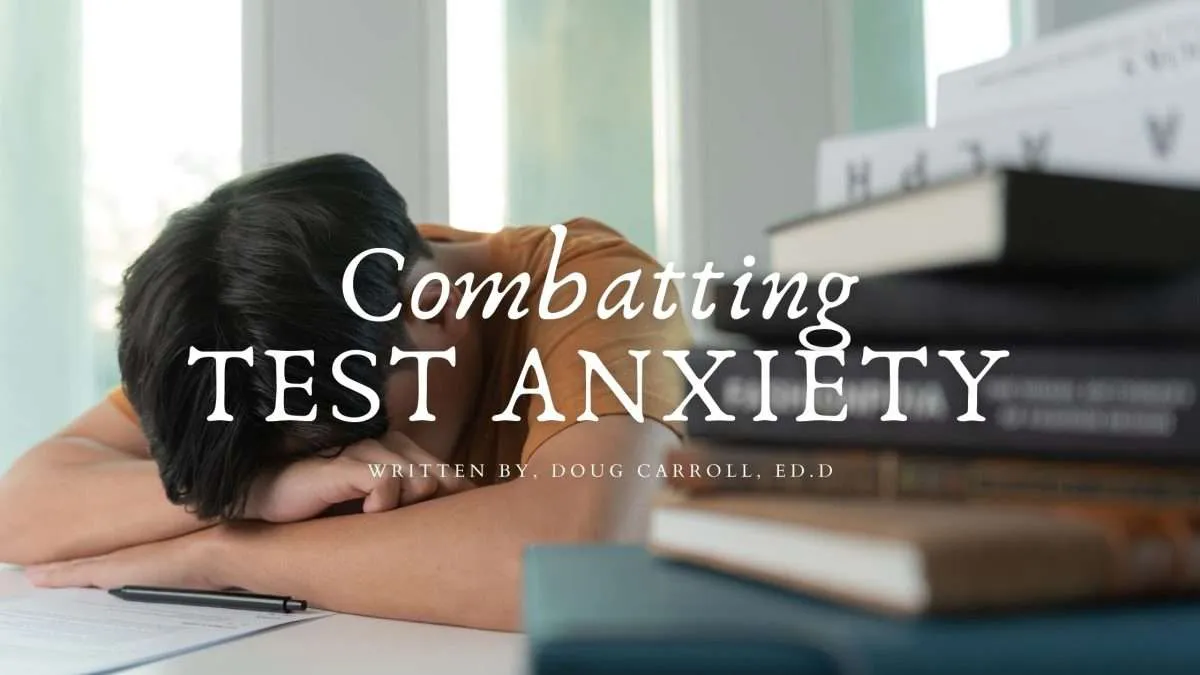Text anxiety is a real thing. The truth is that everyone experiences test anxiety at some point in life.
So, what is test anxiety? What are some ways to combat being overly anxious during a test? Let’s begin with what test anxiety is.
What is it?

Test anxiety is when fear of failing makes it hard to do well on exams. Several anxiety symptoms exist.
Physical symptoms include nausea, headache, shortness of breath, racing heart rate, hands shaking, excessive sweating, or lightheadedness. You may have observed your child complaining of some of these before a test or not wanting to go to school on test days.
In class, students with text anxiety fidget, bite their nails, talk fast, daydream, or flip through the test without answering.
How do we help?
Fear of failure is the root cause of most test anxiety. It interrupts a person’s ability to think or perform an activity.
Fear of failure is an emotional response to an uncomfortable situation. The good news is there are coping skills to reduce test anxiety. What are coping strategies?
Coping skills are actions or thought processes to meet a stressful situation. The goal is to change a negative reaction to a positive response in a stressful situation.
Some coping skills are relatively simple, and you probably do these without realizing you are doing them. For example, getting plenty of quality sleep or staying hydrated. Any healthy habit is technically a coping skill.
Realistic Expectations
Most of the anxiety we have about a situation has to do with our expectations of the outcome. We cannot predict the outcome of a test, which makes us anxious. However, we can control our response to a situation.
If we expect to fail, we will. If we expect to do well, we will do what is necessary to make the outcome positive in our favor.
We need to recognize some things are out of our control. We may not know the specific questions on a test, but we have access to the content where the questions will come from.
Students can use content, teachers, peers, and parents to help them sort through material on a test. This brings us to our first coping skill.
Preparation
Preparation is the best way to defeat test anxiety. Think about it this way…
A teacher spends weeks teaching a concept or subject. Classroom practice and homework occur many times. Why would anyone think that two hours of review the night before a test can replace weeks of instruction?
Daily repetitive review is the best way to defeat test anxiety. We call this repeated practice of skills spiral review.
Spiral Review
A spiral review is when your child practices skills they’ve already mastered or worked on in short bursts over time alongside new content.
Daily review is important in retaining skills and reducing anxiety on tests.
What are some other text anxiety coping skills?
Coping Skills

Recognize Adrenaline
Adrenaline is a hormone released in your body in times of excitement, surprise, and stress. Some of the physical sensations you think are from test anxiety may be the result of adrenaline.
Adrenaline makes your heart beat faster and heightens your awareness. Adrenaline can be a good thing! It makes you focus, and though the sensation feels like anxiety, it’s vastly different.
An adrenaline rush goes away after a few minutes.
Check your perspective
Test anxiety is the fear of failure. Set a realistic picture of what success and failure looks like. I taught students who thought making a 90 on every test was a failure, even though they rarely scored 90. Making a 90 is only a failure if you think it’s a failure.
Remember, one bad grade doesn’t mean pushing the failure panic button. Your teacher probably has different ways for you to improve your grade.
Talk positively to yourself
It seems silly to look in a mirror and repeat aloud, “I am prepared, and I will do well.” Positivity can lower stress and reduce anxiety. Positive self-talk increases confidence and helps you to focus.
Have a Routine
Some people wear lucky socks to stressful tests. If that works for you, then do it! However, rather than rely on lucky socks, create a test routine that you follow before every test. Start about a few days before the test.
Do your spiral review. Get some physical exercise during the week. Rest, enjoy a good breakfast, and get to the test site about ten minutes early.
Check to ensure you have everything you need to take the test – a working calculator, pen, pencils, etc. Once in the classroom, organize your test-taking tools, take a few deep breaths, and do positive self-talk.
Manage Time
When you receive the test, go to the last page first and count the number and type of questions.
Suppose you have thirty multiple-choice items and sixty minutes to complete the test. In that case, you have to answer one question every two minutes. About every ten minutes, you want to see if you are moving too slowly or too quickly.
If you have questions to which you must write an answer, allot more time for these. Do the easy questions and the ones you know first. They will take the least amount of time.
A rule of thumb for tests is “a blank answer is always wrong.” A filled-in answer, even a guess, may be correct or earn some credit.
You Got This!

Don’t let test anxiety get you down. Sometimes, I tell my students that in year from now, they will forget the test or even why they were nervous to start with.
Tests don’t define who you are. Tests are a snapshot of a particular event at a specific time. Just remember to do your best and believe in yourself.
Check out our free BOY and EOY assessments to practice your new skills today! We also have numerous videos on every subject to help your visual learners excel.

